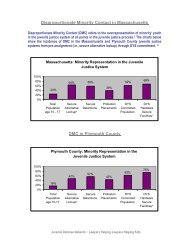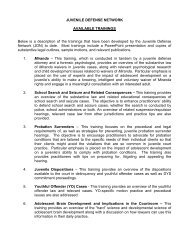States rethink 'adult time for adult crime' - the Youth Advocacy Division
States rethink 'adult time for adult crime' - the Youth Advocacy Division
States rethink 'adult time for adult crime' - the Youth Advocacy Division
You also want an ePaper? Increase the reach of your titles
YUMPU automatically turns print PDFs into web optimized ePapers that Google loves.
Marois explained that he and Jones wanted to study <strong>the</strong> interactions among <strong>the</strong><br />
emotion-generating regions of <strong>the</strong> brain, like <strong>the</strong> amygdala, and <strong>the</strong> prefrontal<br />
regions responsible <strong>for</strong> reason. “It is also possible that <strong>the</strong> prefrontal cortex is<br />
critical <strong>for</strong> attributing punishment, making <strong>the</strong> essential decision about what<br />
kind of punishment to assign,” he suggested. Marois stressed that in order to<br />
study that possibility, more subjects would have to be put into <strong>the</strong> magnet. But if<br />
<strong>the</strong> prefrontal cortex does turn out to be critical <strong>for</strong> selecting among<br />
punishments, Jones added, it could be highly relevant <strong>for</strong> lawyers selecting a jury.<br />
For example, he suggested, lawyers might even select jurors <strong>for</strong> different cases<br />
based on <strong>the</strong>ir different brain-activity patterns. In a complex insider-trading case,<br />
<strong>for</strong> example, perhaps <strong>the</strong> defense would “like to have a juror making decisions on<br />
maximum deliberation and minimum emotion”; in a government entrapment<br />
case, emotional reactions might be more appropriate.<br />
We <strong>the</strong>n turned to <strong>the</strong> results of <strong>the</strong> second experiment, in which I had been<br />
asked to alternate between thinking of faces and places without disclosing <strong>the</strong><br />
order. “We think we can guess what you were thinking about, even though you<br />
didn’t tell us <strong>the</strong> order you started with,” Marois said proudly. “We think you<br />
started with places and we will prove to you that it wasn’t just luck.” Marois<br />
showed me a picture of my parahippocampus, <strong>the</strong> area of <strong>the</strong> brain that responds<br />
strongly to places and <strong>the</strong> recognition of scenes. “It’s lighting up like Christmas<br />
on all cylinders,” Marois said. “It worked beautifully, even though we haven’t<br />
tried this be<strong>for</strong>e here.”<br />
He <strong>the</strong>n showed a picture of <strong>the</strong> fusi<strong>for</strong>m area, which is responsible <strong>for</strong> facial<br />
recognition. It, too, lighted up every <strong>time</strong> I thought of a face. “This is a potentially<br />
very serious legal implication,” Jones broke in, since <strong>the</strong> technology allows us to<br />
tell what people are thinking about even if <strong>the</strong>y deny it. He pointed to a series of<br />
practical applications. Because subconscious memories of faces and places may<br />
be more reliable than conscious memories, witness lineups could be trans<strong>for</strong>med.<br />
A child who claimed to have been victimized by a stranger, moreover, could be<br />
shown pictures of <strong>the</strong> faces of suspects to see which one lighted up <strong>the</strong> facerecognition<br />
area in ways suggesting familiarity.<br />
Jones and Marois talked excitedly about <strong>the</strong> implications of <strong>the</strong>ir experiments <strong>for</strong><br />
<strong>the</strong> legal system. If <strong>the</strong>y discovered a significant gap between people’s hard-wired
















